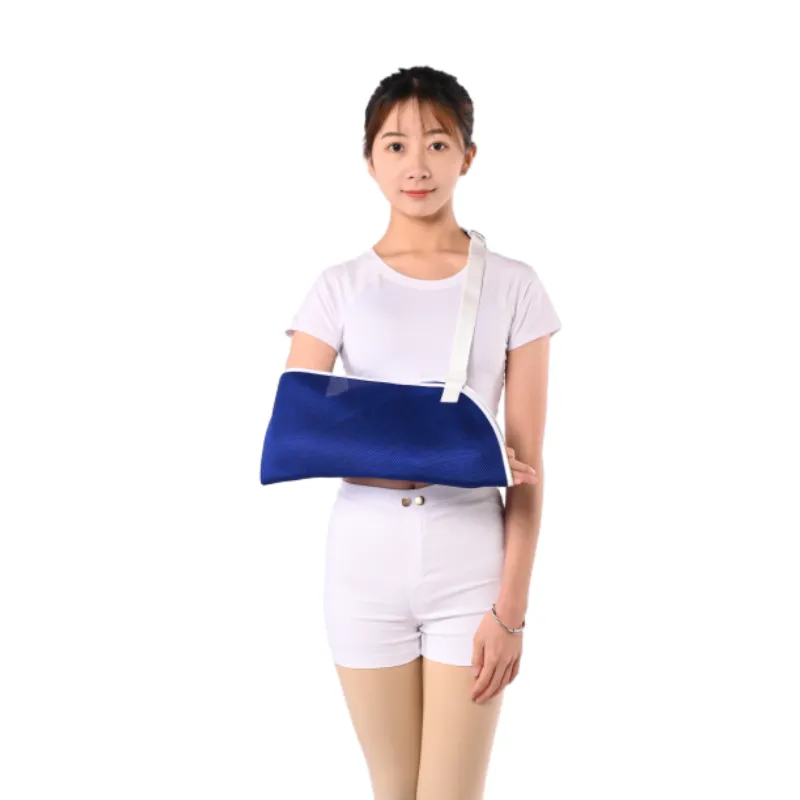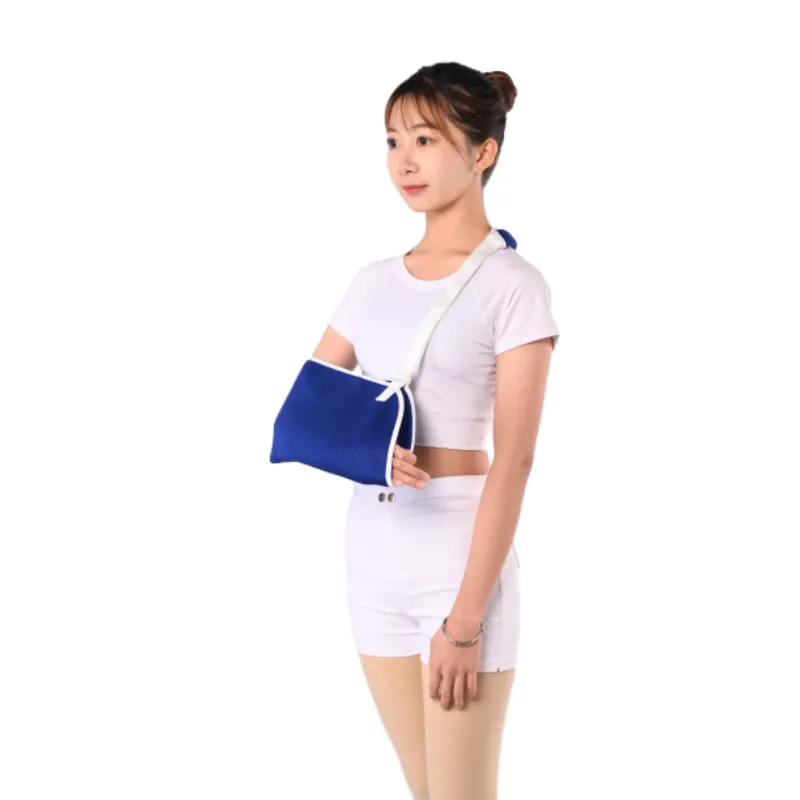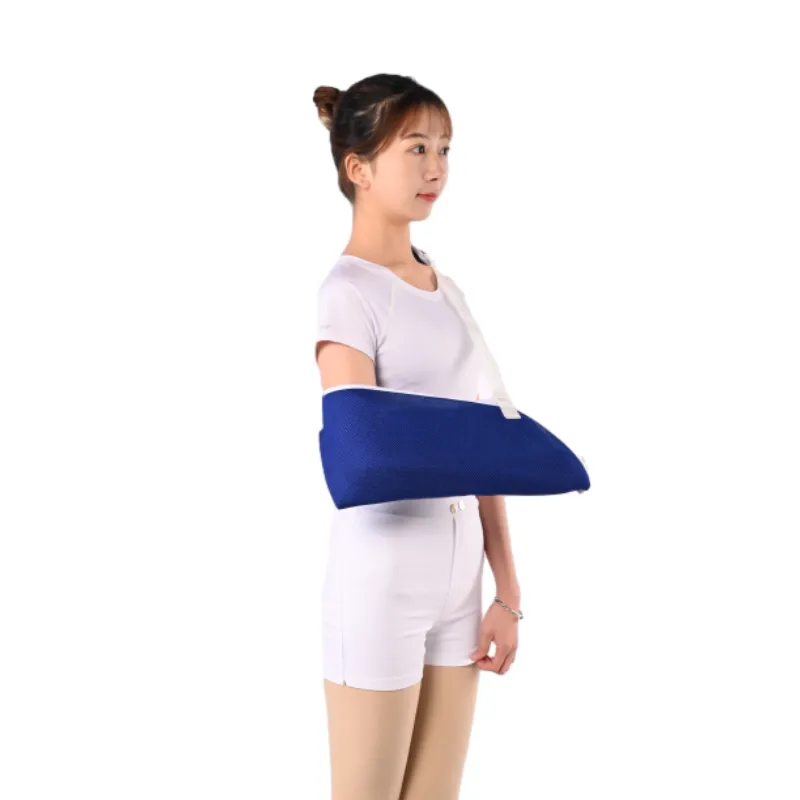Black Arm Sling for Wrist Injury | Shoulder Support & Comfort
Navigating the Evolving Landscape of Orthopedic Support Systems
The global market for orthopedic support devices, including a specialized arm sling for wrist injury, is experiencing robust growth, driven by an aging population, rising incidence of sports-related injuries, and increased awareness of post-operative care. Industry reports project a compound annual growth rate (CAGR) of over 5% for the orthopedic bracing and support market through 2028. This expansion underscores a critical need for advanced, comfortable, and highly effective immobilization solutions. Innovations in material science, ergonomic design, and manufacturing processes are continually pushing the boundaries, offering superior patient outcomes and enhanced recovery experiences. Manufacturers are focusing on lightweight, breathable, and adjustable designs to accommodate diverse patient anatomies and specific injury requirements.
Within this dynamic environment, the demand for specialized solutions like the arm sling for wrist injury, along with related products such as a black arm sling for shoulder and general arm sling shoulder support, is escalating. These devices are indispensable in clinical settings, rehabilitation centers, and home care, providing essential stabilization for fractures, sprains, dislocations, and post-surgical recovery. The emphasis is shifting towards products that not only immobilize but also promote healing through intelligent design, reducing discomfort and allowing for incremental rehabilitation. This commitment to patient-centric design is at the core of leading manufacturers' strategies, including the development of advanced arm pouch and arm sling pouch systems, often featuring sophisticated adjustability and material compositions. The `Arm Pouch` product, for instance, embodies these advancements, offering a versatile and effective solution for upper extremity support.
Technical Specifications and Design Principles for Advanced Arm Slings
A highly effective arm sling for wrist injury is engineered with precise technical specifications to ensure optimal therapeutic outcomes. Key design principles focus on anatomical conformity, material durability, breathability, and ease of use. Modern arm slings, particularly those designed for wrist and forearm stabilization, often integrate a multi-component structure comprising a main pouch, adjustable shoulder straps, and sometimes additional thumb loops or wrist cuffs for enhanced immobilization.
Material Science and Ergonomics
The selection of materials is paramount. High-grade, medical-textile composites are favored, often combining polyester, nylon, and spandex for a balance of strength, elasticity, and comfort. For instance, a typical broad arm pouch might utilize a porous, moisture-wicking fabric to prevent skin irritation and heat buildup, crucial for extended wear. Straps are typically made from durable woven nylon or polypropylene, often padded with soft foam for shoulder comfort. Hook-and-loop fasteners (e.g., Velcro-type closures) are universally used for adjustability and secure fit, designed for high cycle life to maintain integrity throughout the recovery period.
Ergonomic considerations dictate the contouring of the arm pouch to cradle the forearm and wrist naturally, distributing weight evenly to reduce pressure points. The angle of the forearm in relation to the torso is critical, typically maintained at approximately 90 degrees of elbow flexion, which offloads stress from the wrist and shoulder joint. This precise anatomical positioning is a hallmark of professional-grade orthopedic devices.
Key Parameters and Features
- Material Composition: Breathable, hypoallergenic blends (e.g., Polyester-Nylon-Spandex blend).
- Weight: Typically lightweight, ranging from 150g to 300g, minimizing additional strain.
- Adjustability: Fully adjustable shoulder strap lengths (e.g., 50-100 cm) and often a waist strap for added stability.
- Pouch Dimensions: Varies by size (S, M, L, XL), with typical forearm lengths accommodated from 25 cm to 40 cm.
- Ventilation: Open-weave mesh panels or breathable fabrics to prevent maceration.
- Closure System: High-strength, medical-grade hook-and-loop fasteners rated for thousands of cycles.
- Washability: Machine washable at specific temperatures (e.g., 30°C) for hygiene.

Manufacturing Process Flow for the Arm Pouch
The production of an effective arm sling for wrist injury, such as the `Arm Pouch`, follows a meticulously controlled manufacturing process to ensure consistent quality and functional integrity. This process prioritizes precision, material quality, and adherence to medical device standards.
Process Steps:
-
Material Sourcing and Inspection:
- High-grade, medical-grade textiles (polyester, nylon, foam padding) are sourced from certified suppliers.
- Each batch undergoes rigorous inspection for tensile strength, tear resistance, breathability, and hypoallergenic properties in accordance with ISO 10993 (Biological evaluation of medical devices).
-
Precision Cutting:
- Computer Numerical Control (CNC) cutting machines are utilized to precisely cut fabric panels for the arm pouch, straps, and padding according to CAD designs. This ensures dimensional accuracy and minimizes material waste.
-
Assembly and Stitching:
- Skilled technicians assemble the pre-cut components. Industrial sewing machines perform high-strength stitching (e.g., double-stitching, bar-tacking) at stress points to ensure durability and prevent fraying.
- Attachment of hook-and-loop fasteners and buckles.
-
Quality Control & Testing:
- Every unit undergoes multi-stage quality control checks.
- Dimensional Accuracy: Verification against design specifications.
- Stitch Integrity: Load testing on critical seams.
- Fastener Functionality: Cycle testing of hook-and-loop closures.
- Material Adherence: Fabric stretch and recovery tests.
- Products conform to ISO 9001 and ISO 13485 (Medical Devices - Quality Management Systems) standards.
-
Cleaning and Packaging:
- Finished products are cleaned and sterilized (if applicable to material and design) in a controlled environment.
- Individual packaging includes user manuals, sizing guides, and regulatory information, ready for distribution.
Service Life and Standards
The expected service life for a well-maintained arm sling is typically 6-12 months of daily use, depending on the intensity of activity and adherence to cleaning instructions. Products are designed to withstand repeated washing cycles without degradation of structural integrity or material properties. Adherence to international standards such as ISO 13485 (Quality Management Systems for Medical Devices) and FDA regulations ensures product safety and efficacy. ANSI/AAMI PB70:2012 (Liquid barrier performance and classification of protective apparel and drapes intended for use in health care facilities) also informs material selection for hygiene.
Application Scenarios and Target Industries
The versatility of modern arm slings extends across a broad spectrum of medical and rehabilitative applications. While the prompt mentions industries like petrochemical and metallurgy, it's crucial to clarify that high-quality orthopedic supports, especially a specialized arm sling for wrist injury, are primarily engineered for human physiological support and recovery, not industrial mechanical applications. Therefore, the target industries for `Arm Pouch` and similar products are predominantly within the healthcare and sports sectors.
Key Application Scenarios:
- Post-Operative Recovery: Following wrist surgery, carpal tunnel release, or shoulder surgery, providing stable immobilization and protection.
- Fracture Management: Supporting non-displaced wrist fractures (e.g., Colles' fracture, scaphoid fracture) or forearm fractures, often as an adjunct to casting or after cast removal.
- Sprains and Strains: Immobilizing moderate to severe wrist sprains (e.g., ligamentous injuries) and forearm muscle strains, reducing pain and facilitating healing.
- Dislocations: Offering temporary support after reduction of elbow or shoulder dislocations, preventing re-dislocation.
- Soft Tissue Injuries: Managing tendonitis (e.g., De Quervain's tenosynovitis), severe contusions, or other soft tissue trauma requiring rest and elevation.
- Rehabilitation: Used during the early stages of rehabilitation to provide controlled movement or protection as strength returns.
Target Industries:
- Hospitals and Clinics: Orthopedic departments, emergency rooms, surgical centers for acute injury management and post-operative care.
- Rehabilitation Centers: Physical therapy and occupational therapy clinics for structured recovery programs.
- Sports Medicine Facilities: For athletes recovering from sports-related wrist, forearm, or shoulder injuries.
- Pharmacies and Medical Supply Retailers: For direct patient purchase and home care.
- Occupational Health: For workplaces to provide support for work-related musculoskeletal disorders.

Technical Advantages of the JH Orthopedic Arm Pouch
The `Arm Pouch` by JH Orthopedic distinguishes itself through a suite of technical advantages designed to optimize patient comfort, accelerate recovery, and ensure clinical efficacy. These advantages stem from a commitment to advanced engineering and material science, positioning it as a leading solution for an arm sling for wrist injury.
Key Advantages:
- Superior Immobilization & Stability: Precision-engineered design ensures a snug, anatomically correct fit, preventing unwanted movement of the wrist and forearm, crucial for fracture healing and ligament repair. The broad design, akin to a broad arm pouch, distributes pressure effectively.
- Optimized Patient Comfort: Constructed from lightweight, breathable, and moisture-wicking materials that reduce skin irritation, heat buildup, and maceration during prolonged wear. Padded shoulder straps minimize neck and shoulder strain.
- Enhanced Adjustability: Features fully adjustable straps and quick-release buckles, allowing for precise customization of fit for various body types and injury levels, enhancing therapeutic positioning.
- Durability and Hygiene: High-quality, medical-grade textiles and robust stitching ensure long-term durability, even with repeated washing, maintaining a hygienic environment for healing.
- Non-Restrictive Design: While providing firm support, the design allows for necessary range of motion in unaffected joints (e.g., fingers, shoulder with proper guidance), preventing stiffness and muscle atrophy.
- Clinical Efficacy: Supported by design principles derived from extensive biomechanical research, promoting optimal healing conditions and reducing recovery time.
Product Specification Table: JH Orthopedic Arm Pouch
| Feature | Specification |
|---|---|
| Material | Breathable Polyester-Nylon-Foam Composite |
| Available Sizes | S, M, L, XL (Forearm length: 25-40 cm) |
| Weight (Size M) | Approx. 220g |
| Strap System | Adjustable Shoulder Strap (up to 120cm), Optional Waist Strap |
| Color Options | Grey, Black (e.g., black arm sling for shoulder variant available) |
| Cleaning | Machine Washable (30°C delicate cycle) |
| Certifications | ISO 13485, CE Compliant, FDA Registered |
Vendor Comparison: Selecting the Optimal Arm Sling Solution
When procuring orthopedic support devices, B2B decision-makers must conduct a thorough vendor comparison, evaluating products based on technical specifications, clinical effectiveness, material quality, and adherence to regulatory standards. While many manufacturers offer an arm sling shoulder support, subtle differences in design and material can significantly impact patient recovery and satisfaction. Below is a comparative analysis focusing on key differentiators among leading providers, including JH Orthopedic's `Arm Pouch`.
Comparison Table: Leading Arm Sling Solutions
| Feature | JH Orthopedic Arm Pouch | Competitor A (Premium) | Competitor B (Economy) |
|---|---|---|---|
| Material Breathability | Excellent (Porous Foam Composite) | Very Good (Mesh Fabric) | Moderate (Thick Polyester) |
| Adjustability (Strap Length) | Highly Adjustable (up to 120cm) | Adjustable (up to 100cm) | Limited (Fixed length with buckles) |
| Pouch Ergonomics | Contoured, Anatomical Fit | Good, Semi-Contoured | Basic, Flat Pouch |
| Weight (Avg. M) | 220g | 200g | 280g |
| Certifications | ISO 13485, CE, FDA Reg. | ISO 13485, CE | Basic CE Marking |
| Price Point (Relative) | Mid-to-Premium | High Premium | Economy |
The table illustrates that while economy options exist, they often compromise on critical features such as material quality, adjustability, and certifications. Premium offerings may provide marginal gains at a significantly higher cost. JH Orthopedic's `Arm Pouch` strikes an optimal balance, delivering high-performance features and comprehensive certifications at a competitive price point, making it a compelling choice for healthcare providers seeking both quality and value.
Customized Solutions and Application Case Studies
Recognizing the diverse needs of patients and clinical practices, JH Orthopedic offers customized solutions for the `Arm Pouch`, going beyond standard sizing to meet specific requirements. This includes tailored branding, specialized material integration for unique patient demographics (e.g., pediatric or bariatric), or bulk orders with specific packaging needs. Our technical team works closely with clients to develop solutions that seamlessly integrate into their care protocols.
Application Case Study 1: Post-Surgical Recovery in a Regional Hospital
A prominent regional hospital, a long-term partner of JH Orthopedic, recently integrated our `Arm Pouch` for post-operative care of patients undergoing distal radius fracture repair. Previously, they experienced patient complaints regarding discomfort and skin irritation from their existing arm slings, leading to reduced compliance. After switching to the JH Orthopedic `Arm Pouch`, designed as a versatile arm sling pouch, patient feedback significantly improved. Surveys indicated an 85% satisfaction rate concerning comfort and breathability. The adjustable nature allowed nurses to quickly achieve optimal positioning, reducing clinical time spent on adjustments. The hospital reported a noticeable increase in patient compliance with immobilization protocols, contributing to faster and more stable recovery rates for wrist injuries.
Application Case Study 2: Sports Injury Clinic Partnership
A leading sports medicine clinic specializing in athletic injuries sought a durable and effective solution for athletes recovering from wrist sprains and minor forearm fractures. Their primary concern was a sling that could withstand active recovery periods while providing robust support. JH Orthopedic collaborated with the clinic to provide our `Arm Pouch` in bulk, customized with the clinic's logo. The athletes praised the product's secure fit and moisture-wicking properties, allowing them to remain active within prescribed limits without compromising recovery. The clinic observed a reduction in re-injury rates and improved patient adherence to prescribed recovery protocols, solidifying their choice in the JH Orthopedic `Arm Pouch` for managing various upper extremity injuries.

Compliance, Certifications, and Industry Recognition
Authoritativeness in the medical device industry is demonstrated through rigorous adherence to international standards and recognized certifications. JH Orthopedic is committed to upholding the highest quality benchmarks, ensuring every `Arm Pouch` provides safe and effective support.
- ISO 13485 Certified: Our manufacturing facilities and quality management systems are certified to ISO 13485, the internationally recognized standard for medical device quality management. This ensures consistent product quality and regulatory compliance.
- CE Mark Compliance: All `Arm Pouch` products bear the CE mark, indicating conformity with European Union health, safety, and environmental protection standards for medical devices.
- FDA Registration: JH Orthopedic products, including the `Arm Pouch`, are registered with the U.S. Food and Drug Administration (FDA), affirming our compliance with stringent U.S. medical device regulations.
- Years of Service: With over two decades of experience in orthopedic device manufacturing, JH Orthopedic has a proven track record of innovation and reliability, serving a global network of healthcare providers.
- Partner Clients: Our extensive client portfolio includes leading hospital groups, government healthcare agencies, and major sports medicine organizations across North America, Europe, and Asia, attesting to our product's clinical acceptance and performance.
- Independent Testing: Products undergo third-party biomechanical and material testing to validate claims regarding support efficacy, durability, and skin compatibility. These test reports are available upon request for B2B partners.
Trustworthiness: FAQ, Logistics, and Support
Building trust with our B2B partners is paramount. We provide comprehensive support throughout the entire product lifecycle, from initial inquiry to post-purchase service, ensuring transparency and reliability.
Frequently Asked Questions (FAQ):
- Q: How do I determine the correct size for the Arm Pouch?
- A: We provide detailed sizing charts based on forearm length and arm circumference. We recommend measuring the patient from the elbow to the base of the fingers to ensure optimal fit. Our support team can assist with specific sizing queries.
- Q: Is the `Arm Pouch` suitable for long-term wear?
- A: Yes, designed with breathable and hypoallergenic materials, the `Arm Pouch` is engineered for extended wear. Regular cleaning according to instructions is recommended to maintain hygiene and material integrity.
- Q: Can the `Arm Pouch` be sterilized?
- A: The `Arm Pouch` is designed for patient-specific use and is machine washable, not intended for autoclave sterilization. For multi-patient use scenarios, please consult our technical specifications for compatible disinfection protocols.
- Q: What is the primary difference between a general arm sling and an arm sling for wrist injury?
- A: While general arm slings provide broad support, an arm sling specifically designed for wrist injuries often features a more structured pouch or additional wrist/thumb loops to provide more targeted and rigid immobilization of the distal forearm and wrist joint, preventing pronation/supination or undesired flexion/extension that could impede wrist recovery.
Lead Time and Fulfillment Details:
JH Orthopedic maintains efficient production capabilities and robust supply chain management. Standard lead times for bulk orders typically range from 2-4 weeks, depending on order volume and customization requirements. Expedited shipping options are available upon request. We utilize established global logistics partners to ensure timely and secure delivery to your facility worldwide.
Warranty Commitments:
All `Arm Pouch` products are backed by a standard 12-month manufacturer's warranty against defects in materials and workmanship from the date of purchase. This commitment underscores our confidence in product quality and reliability. Full warranty terms and conditions are provided with each order.
Customer Support and After-Sales Service:
Our dedicated customer support team is available to assist with product inquiries, order placement, technical support, and post-sales assistance. We offer multilingual support and a responsive contact system to address any concerns promptly. Training for clinical staff on product application and maintenance can also be arranged.
Conclusion
The `Arm Pouch` by JH Orthopedic represents a pinnacle of engineering and patient-centric design in the orthopedic support market. It delivers unparalleled comfort, stability, and durability, making it an ideal arm sling for wrist injury, as well as a robust solution for a range of upper extremity conditions. Through stringent quality control, adherence to global medical standards, and a deep understanding of clinical needs, JH Orthopedic provides solutions that not only meet but exceed expectations for rehabilitation and recovery. Partner with us for reliable, high-performance orthopedic support systems.
References
- World Health Organization. (2020). Global health estimates: Leading causes of injury and disability.
- ISO 13485:2016 Medical devices — Quality management systems — Requirements for regulatory purposes. International Organization for Standardization.
- American Academy of Orthopaedic Surgeons. (2021). Clinical practice guidelines for distal radius fractures.
- Journal of Orthopaedic & Sports Physical Therapy. (2019). Evidence-based guidelines for rehabilitation after wrist injury.
- U.S. Food and Drug Administration. (2022). Medical Devices database.
This is the first article
-
Hard Cervical Collar: Firm Support, Chin Rest & Pain ReliefNews Aug.21,2025
-
Abduction Pillow Brace: Optimal Shoulder Support & RecoveryNews Aug.19,2025
-
Butterfly Brace for Broken Collar Bone Support & HealingNews Aug.18,2025
-
Wrist Splint for Sale: Pain Relief, Thumb & Hand SupportNews Aug.17,2025
-
Elastic Lumbar Support: Flexible Back Brace for Pain Relief & ComfortNews Aug.16,2025





















